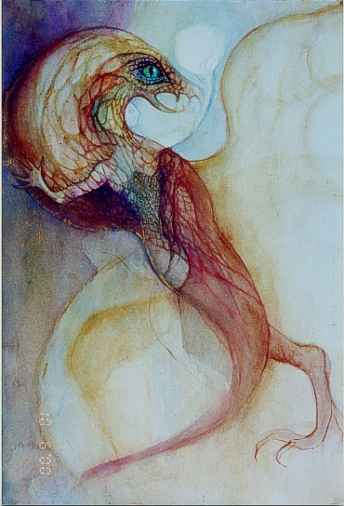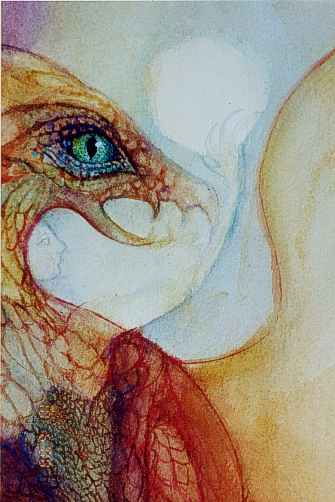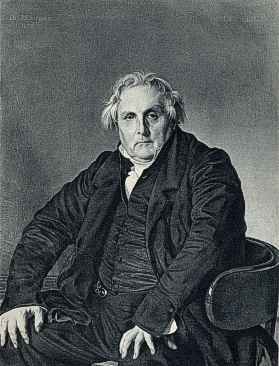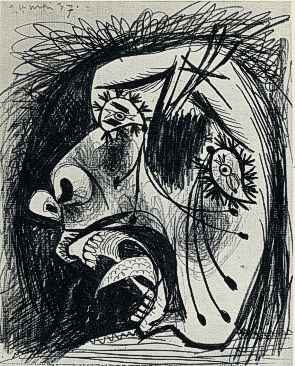So – follow me!

Drat – that dragon is SUCH a pest – he crawls into everybody’s stewpot. But – let’s let him do his thing and talk about design, in its most basic terms. He’s been around a long time & he’s good at it.

Our first element is LINE. As you can see, lines can be thin, delicate, thick, wavy, ragged and jagged – lines can “say” just about anything people want them to say. In Persian carpets, line is an extremely important element. Patterns are often formed on several levels, purely by the use of line. And, Persian lines are frequently curvilinear in nature. In Caucasian carpets, line tends to be straighter, more geometric. In any case, how the artist draws his lines will COMMUNICATE AN IDEA through this visual medium.

Shape is our second element. As you can see, shapes can be geometric or curvy, jagged, leafy – for any idea in the human skull a shape can be conceived to communicate it. In carpet art, shape can take the form of delicate little leaves or huge, formidable arches. Again, the shapes are determined by the message the artist wants to express.
As we’ve discussed previously, some shapes – crosses for example, have a highly symbolic or even iconic – religious – significance. This can vary depending upon culture but it must be remembered that the shape itself has some significance to the subconscious mind, which is why it was adapted to iconographic use in the first place. A form like a cross, if seen in the twigs and grass, can mean – as Patrick has pointed out – that an animal or person has been there and it therefore can serve as a warning. Moon forms have especial importance to women, as our cycles are often timed in synchronization with the phases of the moon. Snakes are so powerful in the human imagination that they have come to represent the fall of Man. Dancers celebrating human fertility imitate them. In many agricultural environments they represent good luck because they eat rodents. They have a powerful double meaning: both as threat and as protector. Probably their powerful winged cousins evolved from simple serpents. The dog-headed serpent of an ancient form of religion practiced by some Kurdish people was thought to represent both good, in the form of the head – and evil, in the form of the body. This embodiment of two ideas in one shape is a form of dualism.
I’m spending quite a bit of time discussing shape here because, in carpet art, it is highly significant. Line is exquisitely well suited to drawing and writing but delicate, expressive lines are harder to do in carpets and are usually found in very fine city carpets. The beautiful Persian carpets I’ve illustrated exemplify the type. They really reflect more of a painter’s art, a designer’s art, than a straightforward weaving technique. Nevertheless they are expressive of their highly stylized and idealized visions of gardens and hunts – ideas that are frequently reinforced by script in the borders.
Most tribal and village weavings express considerably more of the warp/weft structure of their foundation, i.e., they are more geometric in nature. Formally this will mean a more aggressive statement, a composition that will convey energy and power rather than elegance and refinement.

Now space is also an extremely important concept in the visual arts, but especially in carpets. Essentially, no shape can exist without creating a space around it. In kilims, the shape/spaces literally interlock. The negative spaces form exact echoes of the positive spaces. We see this in pile work too, especially in many Anatolian and Caucasian rug borders, in which interlocking arrow-like shapes interact with each other. In East Turkestan rugs one often sees large, tri-lobed borders, again forming perfect interlocking shapes. In some Turkmen pile pieces, there appear to be shapes of elephants complimenting shapes of leaves, or sometimes, in certain white ground asmalyks, the white spaces can look like crouching people.
Frequently, this element is neglected and “space” becomes merely what is “left over” by lines and shapes. However, some artists concentrate on making the negative space very expressive, either as a compliment to the positive space or to actually carry another visual message. I’ll be including some pictures of pieces like this in the thread on Dualism, which I plan to introduce in a couple of days.
There has been a lot of argument on this board about the negative space idea, especially concerning Turkmen rugs. I think it deserves more study. Questions have arisen whether the “elephants” for example, were deliberately intended or exist more or less as an accident of design that occurred while producing the leaf. I don’t know. As I say, it’s an interesting question and the fact that many examples, particularly in painted works, can be found that DO utilize this sort of design, seems to lend some credibility to the theory.

Our next two elements - texture and pattern - are of course extremely important in Oriental rug design. Texture is impossible to ignore in rugs. It can be smooth and silky, velvety, shaggy – one of the great pleasures of this art form. It’s extremely important to Moroccan weavings that utilize bands of pile alternated with bands of flatweave. In this case it is an important design element. In other cases, it’s more or less a result of technique – long or short pile, good or bad wool, and so forth, and can help reinforce the carpet’s “statement” – i.e., shaggy Kazak, velvety expensive-feeling Turkmen.
Pattern, however, is one of the key elements we use in carpet attribution. It is also a subject which never fails to elicit much debate, as people like to argue where this or that pattern originated, how it evolved, so forth. For our purposes, we are not getting into that in this thread. We are going to discuss it from the standpoint of DESIGN LANGUAGE.
The element of pattern, like the other elements discussed in here, serves to help communicate an idea. Pattern can be endless repeats of tiny motifs or it can be one huge, empty field. Usually we are somewhere in between. Rows of botehs are an example of a pattern. The much discussed “herati” motif, when repeated, forms a pattern. A leopard’s spots form a pattern. The very complicated Persian designs will usually be found, upon dissection, to be repetitions of very large and complex patterns. Occasionally one will find that the one pattern covers the entire carpet. Directional designs, like prayer rugs, may include areas of pattern, such as the millefiore areas in Mughal rugs; similarly, a few Yomud pieces are known, which seem to be prayer rugs and are covered with designs that seem to have evolved from flatweaves.

Size and scale are obviously elements of design. Size per se is an absolute – the Pyramids are huge, the Athenian krater is small. Rugs of course can be large or small. This will affect all other aspects of the design – how patterns are adapted to fit, how many borders are used, etc.
Scale is, in the expressive sense, perhaps the more meaningful element in terms of rugs. Scale is the RELATIVE size of objects. In Caucasian rugs, many of the most admired types have relatively LARGE SCALE elements or patterns. They have bold, simple forms rather than tiny delicate ones. Variation of scale of course provides visual interest, is attractive to the eye. Too much variation can be confusing.
Principles, such as variation, alternation, repetition, contrast, balance, dominance, direction, ideas like “visual weight”, all come into play when an artist is designing a piece. One of the great challenges facing the weaver is that she must “see” the image before it is created. Painters can change their minds, to a greater or lesser extent – people working in transparent media like watercolors don’t have nearly as much leeway as people working in oils. Weavers working from cartoons don’t have to go through this process; a designer has done this work. They may have to solve certain technical problems, such as squaring up the design to fit a larger format, or choosing their own colors. In other cases, a person “sings” or “chants” the color changes – this I find fascinating. I assume the person “singing” is reading from a cartoon but some people have asserted this occasionally occurs in memory-based weaving as an aid to visual and “finger” memory.

Volume and Perspective are elements that really only apply, in the FORMAL sense, to three-dimensional objects – for example, sculpture and buildings. However, they are so important to Western art and occasionally APPEAR to occur in Oriental art, that I have included them here. In two-dimensional art – paintings, rugs, they are actually illusions that are created by techniques and, while they help express a statement or tell a story – i.e., COMMUNICATE THE ARTIST’S IDEA – I’m not going to discuss them further at this point.

Now we come to the element which some carpet scholars say is the one that counts first, last, and always: color. It is also the most difficult to master and understand from a formal standpoint. Fortunately there are many excellent works on the subject. For the artist, trial and error and practice and failure are the only real paths to mastery.
For our purposes we’ll just have a brief discussion of the three elements that in turn make up COLOR: hue, value and chroma.
Hue is the – well, it’s the red of the red, the blue of the blue. It’s the exact color of the color, if you will. There are millions of them and only in nature, in light, do colors look like the spectrum. Paint and dye pigments are not “pure” in the sense that light is pure. So, instead of a pure, red red, we have to deal with blue reds, orange reds, brown reds, so forth. Synthetic colors can actually provide the artist with a far broader range than the old vegetable and insect dyes, but the early ones were terrible – harsh, fugitive – and because of the sheer NUMBER of colors available to many weavers, who haven’t studied formal color theory, they can make choices not to our taste although many have wonderful eyes. In any case, color is of course one of the elements that can elicit great emotion in the viewer.
Chroma is the brightness of the hue. This is hard to grasp at first. Think of it this way, for simplification purposes: cool colors, like blues, tend to be duller than hot colors, like reds and yellows. Grays, browns, and other neutrals tend to be duller than most other hues. White can actually have a very intense and unsettlingly bright chroma – this can be good or bad, from a design standpoint. Similarly, subtle grays and browns can reinforce the strength – the brightness, the intensity – of reds and blues and greens. Masterful artists know how to make their colors work to reinforce each other and the overall composition of their piece. We should remember to divorce our value judgments when looking at work that at first might appear to be disturbing, i.e. some people automatically hate anything with bright pinks and oranges. Color is color – it doesn’t care how it got born!
Value is the lightness or darkness of a color. That’s probably not too hard to understand in principal but it can be frustrating in practice. The wrong color VALUE can screw up a composition as much as the wrong hue or chroma. All must work together to make the piece look good and be expressive – i.e., communicate.

Hopefully, this discussion is sharpening the eye and helping us talk DESIGN LANGUAGE. As you see, this is real, objective stuff! These are our tools.
As I mentioned above, the elements are governed by principles, such as contrast, balance, repetition, so forth. What drives the driver? Why, in other words, does an artist make a piece a particular way?
Art has many functions. It can be decorative; it can be religious. It can warn, it can protect. Essentially, though, art exists to communicate. To social animals like people, communication is absolutely a requirement for survival. Communication happens in art both deliberately – i.e., the artist chooses a set of symbols – maybe even words! – and paints them on a wall. Oriental artists frequently write messages on paintings or weave poems into rugs.
And, it can occur accidentally or unconsciously – a particular set of colors, a shape – are unintentionally evocative and the artist decides to leave them that way. We often teach ourselves by making mistakes and having accidents. Oriental artists, who work in sumi ink and watercolors, actually prize the accidents. It makes nature a partner in the work. Children’s art is often amazingly communicative. People making rugs from memory-based patterns might create a brand new design by forgetting a row of knots. Some psychologists do not believe in accidents: art occurs a certain way because the subconscious WANTS it to. The Inner Lion is roaring! He will find a way to get out.
As I’ve said before, quoting Picasso, “nobody knows less about art than critics – except artists”. I would be the first one to agree that the creative process is an endless river of surprises, “miracles”, and mistakes.
Nevertheless, I believe most art is deliberate. Weavers, painters, potters, designers, sculptors – all have something to say. And they choose their elements and arrange them carefully, in order to express their idea.

Here is a portrait by the great French painter, Jean August Dominique Ingres. It’s entitled “Louis Bertin” and dates to 1832 C.E. Ingres was a neo-classicist, a certain type of art that has its roots in Classical Greece and was resurrected during the Renaissance. To put things into perspective, the French Revolution had followed hard upon the heels of the American and the Neo-classicists went to war against the artists of the Rococo, represented in France by Fragonard and Watteau to name a couple. The Neo-classicists wanted to reinforce republican virtues and establish French art on the solid footing of the ancient Greeks and Romans. No more frippery! No more frills! Solid classical form! Strong upright expression! Of course the Romantics immediately rebelled but that’s another story. Suffice it to say, this portrait not only exemplifies the form, it represents a pinnacle for this type of art. Very shortly thereafter, artists would again burst their bonds and create Impressionism, Fauvism, Cubism, Symbolism, Expressionism, Surrealism – all the strange and wonderful forms we consider Modern Art.
Why?

This picture is one of Pablo Picasso’s sketches for his great “Guernica”, dated 1937. Guernica is Picasso’s monument of horror and anguish against the nightmare of mechanized warfare. Look at the difference in viewpoint between this painting and Ingres’ solid French bourgeois. All the self-confidence has been stripped away. The beauty of form has dissolved into the very shape of agony and loss.
The Industrial Revolution had wrought many miracles, but it had also brought warfare and related disasters of unprecedented terror. Marching into the guns at Gettysburg, tens of thousands of Confederate soldiers died in a few short days. Frederick the Great of Prussia lost some 20,000 HORSES in one battle. Famine and disease and poverty stalked the great cities of Europe. Old ways of life, old values, had simply vanished. And World War I, killing millions and millions of people, destroying the best of a generation – it was too much. By the time Guernica was painted, warplanes were in use by the Germans, and the wholesale killing of civilians had joined the horror of the wholesale killing of front-line soldiers. Old empires had collapsed and the evil shape of a new, demonic Reich had reared its head. Picasso and his contemporaries sought forms to express their agony and their dread.
I’ve used these two pictures to illustrate the absolutely inseparable nature of form and expression. In carpet art, form is equally expressive albeit in a generally more abstract manner. But jagged edges still say – jagged edges and they convey a type of form, express a type of emotion. Smooth, curvy forms, soft colors – these say something very different from bold colors and strong, hard-edged forms.
This is the language of the visual artist.

And look who’s back! Can’t seem to get rid of that fellow, can we? And now he’s chasing moths? Or maybe – he’s protecting them from that scorpion.
I think he’s here to stay.